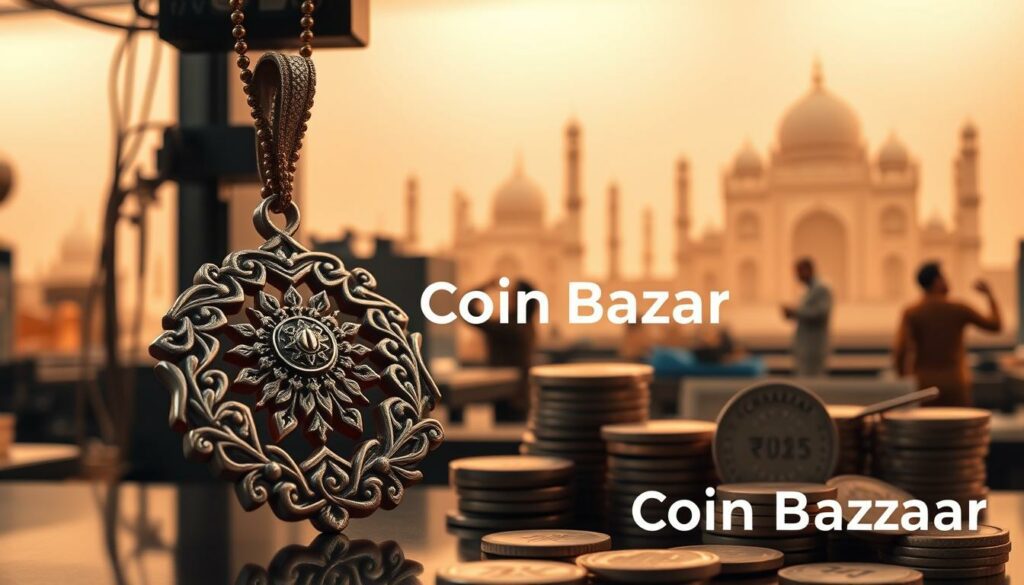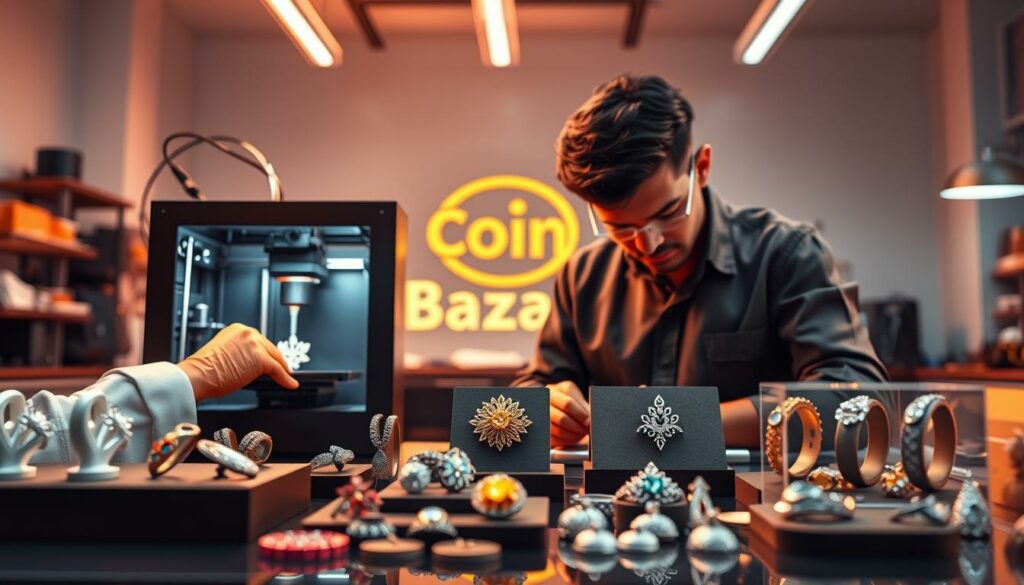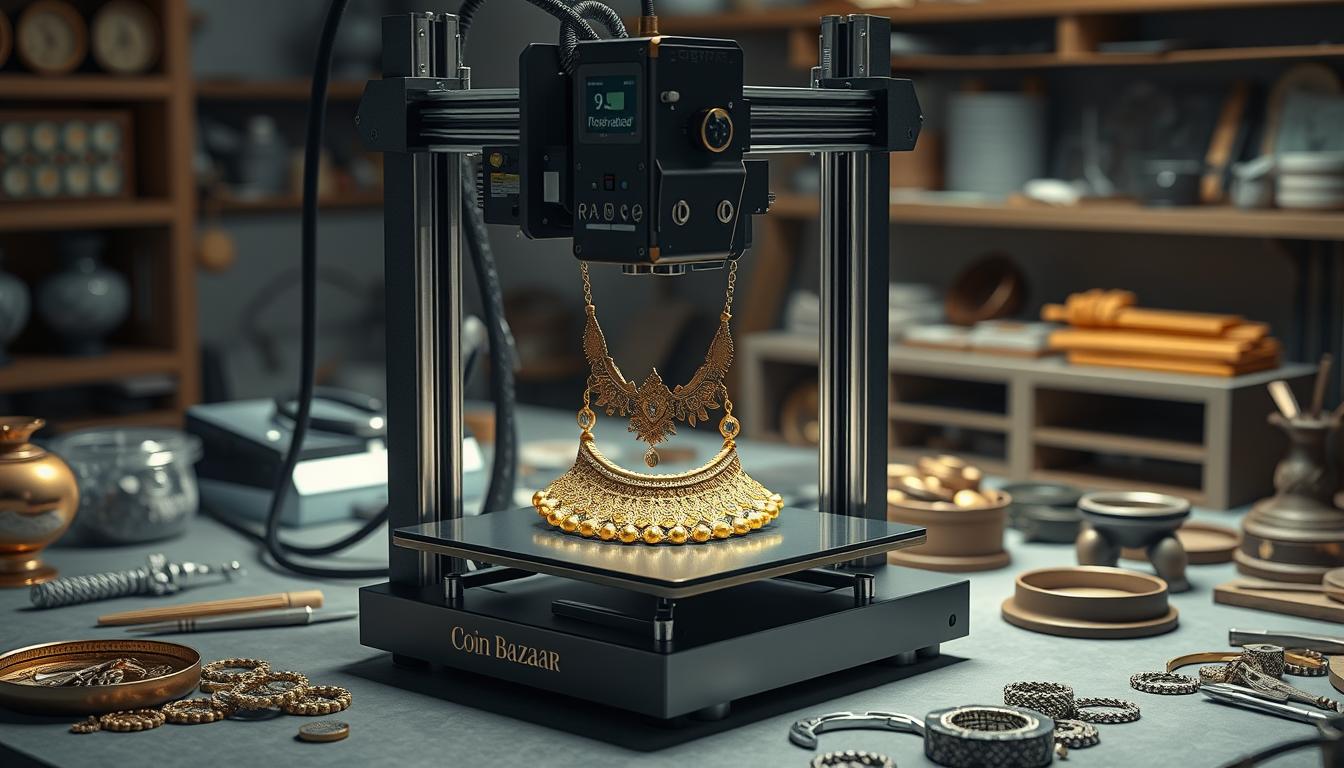The Indian jewelry prototyping industry is changing fast. This is thanks to the quick growth of additive manufacturing.
In the last ten years, 3D printing in India has grown a lot. It has moved from being a small part of manufacturing to a big player. As we look to 2025, new trends are coming. They are changing the industry and making it possible to create complex designs quickly.
The industry revolution will bring big changes. It will make it easier to make detailed jewelry designs fast and accurately.
Key Takeaways
- Growing importance of additive manufacturing in Indian jewelry prototyping
- Emerging trends in 2025 set to revolutionize the industry
- Complex designs and reduced production time
- Precision and speed in jewelry design creation
- Significant changes in the industry due to industry revolution
The Evolution of Jewelry Manufacturing in India
The Indian jewelry world is changing fast with 3D printing. This tech makes detailed designs quickly and accurately. It also lets people make custom pieces faster.
Now, the industry is moving from old-school craftsmanship to new digital ways. Traditional craftsmanship has been key for ages. But, 3D printing brings a new level of precision and complexity to designs. It makes it easier to create detailed pieces that were hard to make before.
From Traditional Craftsmanship to Digital Fabrication
The switch to digital methods is big. It’s because of the need for precision, speed, and complex designs. This means more products for different tastes.
Current Adoption Rates Across Indian Jewelry Hubs
Places like Jaipur and Surat are leading in 3D printing adoption. More makers see its value, like less time to make and 

As 3D printing gets better, more Indian jewelry makers will use it. This will change the industry a lot.
The Economic Impact of 3D Printing on Indian Jewelry Sector
3D printing is changing the Indian jewelry industry a lot. You’ll see big changes in how jewelry is made. This includes design, prototyping, and manufacturing.


Cost Analysis: Traditional vs. 3D Printed Prototyping
3D printing is cheaper than old ways of making prototypes. It saves on material waste and labor costs. Traditional methods use a lot of manual work and waste a lot of materials.
3D printing makes prototypes layer by layer. This cuts down waste and needs less skilled workers. A cost study shows 3D printing can cut prototyping costs by up to 50%.
Market Size Projections for 2025
The 3D printing market in India was about USD 61.4 million in 2023. It’s expected to grow to USD 314.0 million by 2030, with a 26.3% CAGR. The jewelry sector will see big chances because of this.
By 2025, 3D printing will be used more in jewelry. It will help make designs more complex, cut down production time, and save money. The jewelry industry will grow a lot, thanks to 3D printing.
Key 3D Printing Trends 2025 Transforming Indian Jewelry Design
By 2025, Indian jewelry design will see a big change thanks to 3D printing trends. Technology is getting better, and new trends will change how jewelry is made in India.
AI-Integrated Design Systems
Artificial intelligence (AI) is changing 3D printing, especially in design systems. AI helps make designs better and faster. It uses predictive modeling to guess what designs will look like, saving materials and making things more efficient.
AI design systems offer many benefits:
- They make designs more precise
- They save materials
- They make workflows better
- They let you create complex designs
Multi-Material Printing Capabilities
Multi-material printing is opening up new possibilities in jewelry design. It lets you print with different materials at the same time. This means you can make pieces with unique textures, colors, and properties.
Multi-material printing has many advantages:
- It lets you create more complex designs
- It uses sustainable materials
- It allows for unique textures and colors
- It makes designs look better
Nano-Scale Resolution for Intricate Indian Designs
Nano-scale resolution in 3D printing lets you make designs that were hard to do before. It’s perfect for detailed Indian motifs and patterns. As technology gets better, you’ll see even more detailed designs.
The benefits of nano-scale resolution are:
- It makes intricate designs with high detail
- It helps keep cultural heritage alive
- It lets you create elaborate designs
- It adds more precision
Materials Revolution in Jewelry Prototyping
A big change is happening in jewelry making. New materials are coming in, making 3D printing better. Now, we can make more detailed and high-quality jewelry designs.
Direct Precious Metal Printing Advancements
Direct precious metal printing has made big steps forward. It lets us make jewelry from gold, silver, and other metals straight from designs. This method cuts down on time and makes things more precise.
For example, it’s now possible to make detailed gold pieces. These were hard to make before with old methods.
Bio-Inspired and Sustainable Materials
There’s a growing trend towards using bio-inspired and sustainable materials. Jewelry made from recycled or biomaterials is becoming popular. It looks good and is good for the planet.
This change is because people want eco-friendly products. It also helps the industry be less harmful to the environment.
Composite Materials for Enhanced Durability and Aesthetics
Composite materials are being made to make 3D-printed jewelry better. They mix different qualities like strength, color, and texture. This creates unique and beautiful pieces.
For instance, some composites look like precious stones. Others have special textures. This makes the jewelry more appealing.
The materials revolution will keep going. There’s always new research and development. So, the jewelry industry will keep getting better in quality, variety, and being green.
Preserving Cultural Heritage Through Advanced Printing Techniques
3D printing is more than just a tech leap; it’s a link between India’s rich past and its future. It helps keep traditional Indian designs alive by turning them into digital models. Now, you can see the fine details of old jewelry made with exactness.
Digitizing Traditional Indian Motifs and Patterns
Digitizing traditional designs means making detailed digital copies of old patterns. This keeps these designs safe for future generations. Advanced software makes it possible to add these designs to modern jewelry.
Recreating Regional Jewelry Styles with 3D Technology
India’s jewelry styles vary greatly, each with its own story and meaning. 3D printing technology brings these styles back to life with amazing detail. It mixes old craftsmanship with new tech, changing the jewelry world in India.
| Region | Traditional Style | 3D Printing Innovation |
|---|---|---|
| Rajasthan | Intricate Kundan Work | Precision in replicating intricate designs |
| Karnataka | Detailed Filigree | Enhanced durability and detail retention |
| Tamil Nadu | Temple Jewelry | Accurate scaling and complex geometries |
With 3D printing, the Indian jewelry world is not just keeping its traditions alive. It’s also moving forward with tech. This mix of old and new is making the industry more competitive and creative.
Micro-Detailed Printing for Temple and Bridal Jewelry
Indian jewelers are now making complex designs with great precision thanks to additive manufacturing. This tech helps in making detailed temple and bridal jewelry. It’s a big step up from old methods.
Achieving Filigree and Jali Work Through Additive Manufacturing
Filigree and jali work are old Indian jewelry-making skills. They need very detailed metalwork. Additive manufacturing makes it easy to copy these designs. This lets jewelers make the detailed patterns seen in Indian temple and bridal jewelry.
Key benefits of additive manufacturing for filigree and jali work include:
- Enhanced precision in intricate designs
- Ability to create complex geometries
- Reduced material waste
Gemstone Setting Innovations for 3D Printed Pieces
Setting gemstones is key in jewelry making. 3D printing has brought new ways to add gemstones to printed pieces. Jewelers are trying out designs that include settings or setting gemstones after printing.
| Innovation | Description | Benefit |
|---|---|---|
| Integral Setting Design | Designing gemstone settings as part of the 3D printed jewelry piece | Enhanced durability and aesthetic appeal |
| Post-Printing Setting | Setting gemstones into 3D printed jewelry after the printing process | Flexibility in gemstone selection and setting |
Exploring micro-detailed printing for temple and bridal jewelry opens up new possibilities. You can use these innovations to make unique, detailed pieces. These pieces will show off the beauty of Indian craftsmanship.
Mass Customization: The New Standard by 2025
By 2025, the Indian jewelry industry will likely use mass customization. This change is because of the growing need for unique, personalized jewelry. People want pieces that show off their individual style.
3D printing makes it easy to create custom jewelry in large quantities. This is great for businesses wanting to stand out. By offering custom options, Indian jewelry makers can meet more customer needs. This could lead to happier customers and more loyalty.
Customer-Driven Design Platforms for Indian Consumers
Design platforms are changing how Indian shoppers buy jewelry. These platforms let people design their own jewelry. They can pick from many templates, materials, and designs. 3D printing technology helps make these custom designs quickly and efficiently.
For example, brands can use online tools for customers to tweak designs or make new ones. This improves the shopping experience. It also helps brands understand what customers like, guiding future designs and production.
Balancing Personalization with Production Efficiency
Mass customization brings big chances but also challenges. To keep up with demand and stay efficient, makers need to use predictive modeling and market forecasting. This helps them plan and manage production better.
| Production Aspect | Traditional Manufacturing | 3D Printing |
|---|---|---|
| Customization Level | Limited | High |
| Production Time | Longer lead times | Rapid production |
| Cost Efficiency | Economies of scale | Cost-effective for small batches |
Indian jewelry companies can use 3D printing to balance custom products and efficient production. This is key for the future of making jewelry in India.
Hybrid Manufacturing: Blending Tradition with Technology
Hybrid manufacturing is becoming popular in India’s jewelry industry. It combines traditional craftsmanship with modern technology. This mix lets jewelry makers use the strengths of both, adding detailed designs and cultural value to their work.
Artisan-Technology Collaboration Models
The success of hybrid manufacturing comes from teamwork between artisans and technology. 3D printing technology is being used in traditional jewelry making. This lets artisans create complex designs that were hard to make before.
This teamwork boosts design options and keeps traditional skills alive. It makes them fit for today’s market.
Case Studies from Jaipur and Surat Jewelry Districts
Jewelry areas like Jaipur and Surat are leading in hybrid manufacturing. In Jaipur, artisans use 3D printing for Kundan and Meenakari designs. In Surat, makers create intricate diamond-studded jewelry with hybrid methods. These examples show how hybrid manufacturing can improve productivity and innovation in Indian jewelry.
By adopting hybrid manufacturing, Indian jewelry companies can lead an industry revolution. They use technology advancements and new strategies. This helps them succeed in the global market.
On-Demand Production Transforming Retail Models
The Indian jewelry industry is getting ready for 2025, and on-demand production is changing retail. 3D printing is helping retailers use new strategies. These strategies cut down on inventory and make customers happier.
The old way of retail, stocking lots of products, is facing a challenge. On-demand production lets retailers make jewelry as it’s ordered. This cuts down on storage needs and reduces the chance of products going unsold.
Zero-Inventory Approaches for Indian Jewelry Retailers
Thanks to 3D printing, Indian jewelry retailers can now use zero-inventory methods. They make pieces as they’re ordered, saving on storage and inventory management costs.
This method also lets retailers offer more designs without the high upfront costs. They don’t have to produce and store lots of jewelry beforehand.
Just-in-Time Manufacturing for Seasonal Collections
Just-in-time manufacturing is great for seasonal collections. With 3D printing, retailers can quickly make seasonal pieces as they’re needed.
For example, a retailer can create a new design for a season and make it with 3D printing as orders come in. This way, they can meet demand without having too much inventory.
| Benefits | Traditional Method | On-Demand Production |
|---|---|---|
| Inventory Costs | High | Low |
| Production Flexibility | Limited | High |
| Response to Trends | Slow | Fast |
Digital Customer Experiences in Jewelry Shopping
Digital technologies are changing how people in India buy jewelry. Now, shopping is more personal and fun. New tech like AR/VR and virtual showrooms is making jewelry stores better.
AR/VR Try-On Solutions for Traditional and Contemporary Designs
AR/VR try-on solutions are making jewelry shopping better. They let you try on jewelry online. This means you don’t have to go to the store.
For example, you can see how jewelry looks on you without trying it on. This saves time and makes you happier with your choice.
Virtual Showrooms and Their Impact on Physical Retail
Virtual showrooms are also changing jewelry shopping. They let you look at lots of jewelry anytime, anywhere.
Virtual showrooms help physical stores too. They don’t replace them but make shopping better. Stores can reach more people and give a better experience.
| Technology | Impact on Jewelry Shopping | Benefits |
|---|---|---|
| AR/VR Try-On | Enhanced customer experience | Increased customer satisfaction, reduced returns |
| Virtual Showrooms | 24/7 shopping convenience | Wider audience reach, increased sales |
By using these technology advancements and innovation strategies, Indian jewelry stores can offer a better shopping experience. It’s more fun and personal for customers.
Blockchain and IoT Integration in Jewelry Authentication
The Indian jewelry industry is getting ready for 2025. It’s going to see big changes with blockchain and IoT technologies. These new tools will change how we check if jewelry is real.
Experts say this change is huge. It will make checking jewelry’s authenticity better.
Recently, someone said:
“Growing adoption of blockchain technology in the jewelry industry will ensure more transparent and tamper-proof transaction records,”
This shows how powerful blockchain can be.
This mix of technologies has two key parts:
Traceability Solutions for Ethical Sourcing
Blockchain and IoT help make traceability solutions. These solutions make sure materials used in jewelry come from good sources. This is key because people want to know where their jewelry comes from.
Digital Provenance for 3D Printed Luxury Pieces
Digital provenance is key for 3D-printed luxury pieces. It keeps a record of a piece’s history, from design to when it’s made. This proves the piece is real and gives buyers useful info.
This tech is changing the jewelry world. It’s making the industry more open and trustworthy.
Overcoming Adoption Barriers in Indian Market
Exploring 3D printing in the Indian jewelry industry reveals several challenges. Small and medium-sized enterprises face hurdles like high costs and a lack of skilled workers. These factors slow down the adoption of 3D printing in jewelry.
Investment Models for Small and Medium Jewelers
For small and medium jewelers, the cost of starting with 3D printing is a big issue. To help, different investment models can be used. Options like leasing or flexible financing from tech providers can make it easier to start.
Skill Development Programs for Digital Craftsmanship
The need for skilled workers is another big challenge. To solve this, skill development programs for digital craftsmanship are needed. These programs should be made with tech providers and vocational schools. They aim to train the current workforce and boost their skills.
Addressing Cultural Resistance to Technology
Many people are hesitant to adopt new technology. To overcome this, showing the benefits of 3D printing is key. Case studies and success stories from the industry can help. They can build trust and encourage traditional jewelers to try the technology.
Government Initiatives Supporting Technological Advancement
Government support is key in driving the industry revolution in Indian jewelry making. The Indian government has launched several plans to boost tech in the field.
Make in India Impact on Jewelry Manufacturing Technology
The “Make in India” program has been a big help in tech progress in jewelry making. It brings in foreign money and encourages new ideas. This has made making jewelry faster and better.
Some main benefits of “Make in India” for jewelry making are:
- More foreign money in the field
- Use of the latest tech
- Better quality and design in products
| Initiative | Impact on Jewelry Manufacturing |
|---|---|
| Make in India | Promoted tech progress and foreign investment |
| State-Level Incentives | Helped local use of advanced tech |
State-Level Incentives for Technology Adoption
Along with national efforts, many state governments in India have their own plans. They offer help like subsidies, tax breaks, and support for learning new skills.
For example, Gujarat and Maharashtra have special policies to draw in jewelry making investments. They offer great deals. These state efforts work with national programs like “Make in India” to push the future of manufacturing in India.
Thanks to these government plans, jewelry makers in India can lead in the global market. They can use new tech like 3D printing to their advantage.
Success Stories: Indian Jewelry Brands Leading the 3D Revolution
The 3D printing revolution is changing the Indian jewelry sector. Many Indian jewelry brands are using this technology to transform digitally and shake up traditional markets. Both old and new brands are bringing their special skills to the table.
Heritage Brands Embracing Digital Transformation
Heritage brands in India are using 3D printing to keep traditional skills alive while looking to the future. For example, Tanishq is making complex designs with 3D printing that were hard to make before. This mix of old and new is helping these brands stay ahead in a tough market.
Heritage brands are gaining from 3D printing in many ways:
- They can make more detailed designs
- They work more efficiently
- They can offer unique products
Tech-First Startups Disrupting Traditional Markets
Tech-first startups are also making a big difference. They’re using 3D printing to create new and personalized jewelry designs. These startups are using tech and innovation to guess what the market and customers will want next.
| Startup | Innovation | Impact |
|---|---|---|
| Brand A | Customizable designs using AI and 3D printing | Increased customer engagement |
| Brand B | Use of sustainable materials in 3D printing | Appeal to eco-conscious consumers |
| Brand C | Integration of AR/VR for virtual try-on | Enhanced customer experience |
Implementation Roadmap for 2025-Ready Jewelry Businesses
To stay ahead by 2025, you must create a detailed plan. This plan should include the latest 3D printing trends in the Indian jewelry market. It will guide you through adopting new technologies and fitting them into your business.
Technology Assessment and Selection Framework
When picking 3D printing tech, look at material quality, precision, and speed. A solid framework helps you pick the right tech for your business. For example, use a scoring system to compare technologies based on what matters to you.
- Define your business needs and goals
- Research and narrow down 3D printing options
- Compare each tech based on your criteria
- Pick the tech that fits your business best
Integration Strategies for Various Business Sizes
Integration plans differ by business size. Small businesses might start simple and grow. Large businesses need more complex plans, including employee training and new equipment. Tailor your plan to your business size.
ROI Calculation Models for Technology Investment
To figure out 3D printing’s ROI, use different models. Compare traditional and 3D printing costs. Also, think about 3D printing’s benefits, like less waste and faster production.
For example, a jewelry company using 3D printing could cut production time. This lets them handle more orders and boost their earnings.
Conclusion: Positioning Your Jewelry Business for the Future
The jewelry industry is on the verge of a big change. This change comes from 3D printing and other new technologies. It’s crucial to get your business ready for this shift.
These new trends can help you stay ahead. By using 3D printing and other digital tools, you can work smarter and cheaper. You can also make products that fit what Indian customers want.
To keep up, you need to invest in the newest tech and learn how to use it. This way, you’ll be ready to take advantage of the changes. You’ll do well in a market that’s always moving.














